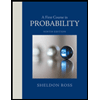
A First Course In Probability, Global Edition
10th Edition
ISBN: 9781292269207
Author: Ross, Sheldon
Publisher: PEARSON
expand_more
expand_more
format_list_bulleted
Concept explainers
Question
Chapter 8, Problem 8.16TE
(a)
To determine
To show:
(b)
To determine
To show:
(c)
To determine
To show:
(d)
To determine
To show:
The Gini index of a uniform
Expert Solution & Answer
Want to see the full answer?
Check out a sample textbook solution
Students have asked these similar questions
When a tennis player serves, he gets two chances to serve in bounds. If he fails to do so twice, he loses the point. If he
attempts to serve an ace, he serves in bounds with probability 3/8.If he serves a lob, he serves in bounds with probability
7/8. If he serves an ace in bounds, he wins the point with probability 2/3. With an in-bounds lob, he wins the point with
probability 1/3. If the cost is '+1' for each point lost and '-1' for each point won, the problem is to determine the optimal
serving strategy to minimize the (long-run)expected average cost per point. (Hint: Let state 0 denote point over,two
serves to go on next point; and let state 1 denote one serve left.
(1). Formulate this problem as a Markov decision process by identifying the states and decisions and then finding the
Cik.
(2). Draw the corresponding state action diagram.
(3). List all possible (stationary deterministic) policies.
(4). For each policy, find the transition matrix and write an expression for the…
During each time period, a potential customer arrives at a restaurant with probability 1/2. If there are already two people
at the restaurant (including the one being served), the potential customer leaves the restaurant immediately and never
returns. However, if there is one person or less, he enters the restaurant and becomes an actual customer. The manager
has two types of service configurations available. At the beginning of each period, a decision must be made on which
configuration to use. If she uses her "slow" configuration at a cost of $3 and any customers are present during the period,
one customer will be served and leave with probability 3/5. If she uses her "fast" configuration at a cost of $9 and any
customers are present during the period, one customer will be served and leave with probability 4/5. The probability of
more than one customer arriving or more than one customer being served in a period is zero. A profit of $50 is earned
when a customer is served. The manager…
Every Saturday night a man plays poker at his home with the same group of friends. If he provides refreshments for the
group (at an expected cost of $14) on any given Saturday night, the group will begin the following Saturday night in a
good mood with probability 7/8 and in a bad mood with probability 1/8. However, if he fail to provide refreshments, the
group will begin the following Saturday night in a good mood with probability 1/8 and in a bad mood with probability
7/8 regardless of their mood this Saturday. Furthermore, if the group begins the night in a bad mood and then he fails
to provide refreshments, the group will gang up on him so that he incurs expected poker losses of $75. Under other
circumstances he averages no gain or loss on his poker play. The man wishes to find the policy regarding when to
provide refreshments that will minimize his (long-run) expected average cost per week.
(1). Formulate this problem as a Markov decision process by identifying the states and…
Chapter 8 Solutions
A First Course In Probability, Global Edition
Ch. 8 - Suppose that X is a random variable with mean and...Ch. 8 - From past experience, a professor knows that the...Ch. 8 - Use the central limit theorem to solve part (c) of...Ch. 8 - Let X1,...,X20 be independent Poisson random...Ch. 8 - Fifty numbers are rounded off to the nearest...Ch. 8 - A die is continually rolled until the total sum of...Ch. 8 - A person has 100 light bulbs whose lifetimes are...Ch. 8 - In Problem 8.7, suppose that it takes a random...Ch. 8 - If X is a gamma random variable with parameters...Ch. 8 - Civil engineers believe that W, the amount of...
Ch. 8 - Many people believe that the daily change of price...Ch. 8 - We have 100 components that we will put in use in...Ch. 8 - Student scores on exams given by a certain...Ch. 8 - A certain component is critical to the operation...Ch. 8 - An insurance company has 10.000 automobile...Ch. 8 - A.J. has 20 jobs that she must do in sequence,...Ch. 8 - Redo Example 5b under the assumption that the...Ch. 8 - Repeat part (a) of Problem 8.2 when it is known...Ch. 8 - A lake contains 4 distinct types of fish. Suppose...Ch. 8 - If X is a nonne9ative random variable with mean...Ch. 8 - Let X be a nonnegative random variable. Prove that...Ch. 8 - Prob. 8.22PCh. 8 - Let X be a Poisson random variable with mean 20....Ch. 8 - Prob. 8.24PCh. 8 - Prob. 8.25PCh. 8 - If f(x) is an Increasing and g(x) is a decreasing...Ch. 8 - If L(p) is the Lorenz curve associated with the...Ch. 8 - Suppose that L(p) is the Lorenz curve associated...Ch. 8 - If X has variance 2, then , the positive square...Ch. 8 - If X has mean and standard deviation , the ratio...Ch. 8 - Compute the measurement signal-to-noise ratio-that...Ch. 8 - Let Zn,n1, be a sequence of random variables and...Ch. 8 - Prob. 8.5TECh. 8 - Prob. 8.6TECh. 8 - Prob. 8.7TECh. 8 - Explain why a gamma random variable with...Ch. 8 - Prob. 8.9TECh. 8 - If X is a Poisson random variable with mean , show...Ch. 8 - Prob. 8.11TECh. 8 - Prob. 8.12TECh. 8 - Prob. 8.13TECh. 8 - Prob. 8.14TECh. 8 - If f and g are density functions that are positive...Ch. 8 - Prob. 8.16TECh. 8 - The number of automobiles sold weekly at a certain...Ch. 8 - Prob. 8.2STPECh. 8 - If E[X]=75E[Y]=75Var(X)=10var(Y)=12cov(X,Y)=3 give...Ch. 8 - Prob. 8.4STPECh. 8 - Prob. 8.5STPECh. 8 - Prob. 8.6STPECh. 8 - Prob. 8.7STPECh. 8 - Prob. 8.8STPECh. 8 - Prob. 8.9STPECh. 8 - A tobacco company claims that the amount of...Ch. 8 - Prob. 8.11STPECh. 8 - Prob. 8.12STPECh. 8 - The strong law of large numbers states that with...Ch. 8 - Each new book donated to a library must be...Ch. 8 - Prove Chebyshevs sum inequality, which says that...
Knowledge Booster
Learn more about
Need a deep-dive on the concept behind this application? Look no further. Learn more about this topic, probability and related others by exploring similar questions and additional content below.Similar questions
- This year Amanda decides to invest in two different no-load mutual funds: the G Fund or the L Mutual Fund. At the end of each year, she liquidates her holdings, takes her profits, and then reinvests. The yearly profits of the mutual funds depend on where the market stood at the end of the preceding year. Recently the market has been oscillating around level 2 from one year end to the next, according to the probabilities given in the following transition matrix : L1 L2 L3 L1 0.2 0.4 0.4 L2 0.1 0.4 0.5 L3 0.3 0.3 0.4 Each year that the market moves up (down) 1 level, the G Fund has profits (losses) of $20k, while the L Fund has profits (losses) of $10k. If the market moves up (down) 2 level in a year, the G Fund has profits (losses) of $50k, while the L Fund has profits (losses) of only $20k. If the market does not change, there is no profit or loss for either fund. Amanda wishes to determine her optimal investment policy in order to maximize her (long-run) expected average profit per…arrow_forwardSolve this questions pleasearrow_forwardQuestion 1: Let X be a random variable with p.m.f (|x| +1)² x= -2, -1, 0, 1,2 f(x) = C 0, O.W 1. The value of c. 2. The c.d.f. 3. E(X). 4. E(2x+3). 5. E(X²). 6. E(3x²+4). 7. E(X(3X+4)). 8. Var(X). 9. Var (6-3X). 10. Find the m.g.f of the random variable Xarrow_forward
- Please could you explain how to do integration by parts for this question in detail pleasearrow_forward2. Claim events on a portfolio of insurance policies follow a Poisson process with parameter A. Individual claim amounts follow a distribution X with density: f(x)=0.0122re001, g>0. The insurance company calculates premiums using a premium loading of 45%. (a) Derive the moment generating function Mx(t).arrow_forwardX GG G + C td.bksblive2.com.au/bksblive2/Play... E R New Chrome available CANVAS gmetrix N notion Six big immigratio... >>> All Bookmarks 1.1 ACSF L5 SC Geometry and Measure: Vectors Vectors State the vector quantities shown on the image below. AB = CD' = A B D < C 80 esc F1 F2 F3 F4 ? Help 7arrow_forward
- 2. Claim events on a portfolio of insurance policies follow a Poisson process with parameter A. Individual claim amounts follow a distribution X with density: f(x)=0.0122re001, g>0. The insurance company calculates premiums using a premium loading of 45%. (a) Derive the moment generating function Mx(t).arrow_forward2. Claim events on a portfolio of insurance policies follow a Poisson process with parameter A. Individual claim amounts follow a distribution X with density: f(x)=0.0122re001, g>0. The insurance company calculates premiums using a premium loading of 45%. (a) Derive the moment generating function Mx(t).arrow_forwardQ2 H let x(+) = &cos (Ait+U) and. 4(+) = ß cos(12t +V), where d. B. 1. In Constants and U,V indep.rus have uniform dist. (-π,π) Show that: ①Rxy (+,4+1)=0 @ Rxy (++) = cos [ when U=V Q3 let x(t) is stochastic process with Wss -121 e, and Rx ltst+1) = ( 2, show that E(X) = E(XS-X₁)² = 2(-1). Qu let x(t) = U Cost + (V+1) Sint, tεIR. where UV indep.rus, and let E (U)-E(V)=0 and E(U) = E(V) = 1, show that Cov (Xt, Xs) = K (t,s) = cos(s-t) X(+) is not WSS.arrow_forward
- Patterns in Floor Tiling A square floor is to be tiled with square tiles as shown. There are blue tiles on the main diagonals and red tiles everywhere else. In all cases, both blue and red tiles must be used. and the two diagonals must have a common blue tile at the center of the floor. If 81 blue tiles will be used, how many red tiles will be needed? For what numbers in place of 81 would this problem still be solvable? Find an expression in k giving the number of red tiles required in general.arrow_forwardAt a BBQ, you can choose to eat a burger, hotdog or pizza. you can choose to drink water, juice or pop. If you choose your meal at random, what is the probability that you will choose juice and a hot dog? What is the probability that you will not choose a burger and choose either water or pop?arrow_forwarda card is drawn from a standard deck of 52 cards. If a card is choosen at random, what is the probability that the card is a)heart b)a face card or c)a spade or 10arrow_forward
arrow_back_ios
SEE MORE QUESTIONS
arrow_forward_ios
Recommended textbooks for you
 A First Course in Probability (10th Edition)ProbabilityISBN:9780134753119Author:Sheldon RossPublisher:PEARSON
A First Course in Probability (10th Edition)ProbabilityISBN:9780134753119Author:Sheldon RossPublisher:PEARSON

A First Course in Probability (10th Edition)
Probability
ISBN:9780134753119
Author:Sheldon Ross
Publisher:PEARSON

Continuous Probability Distributions - Basic Introduction; Author: The Organic Chemistry Tutor;https://www.youtube.com/watch?v=QxqxdQ_g2uw;License: Standard YouTube License, CC-BY
Probability Density Function (p.d.f.) Finding k (Part 1) | ExamSolutions; Author: ExamSolutions;https://www.youtube.com/watch?v=RsuS2ehsTDM;License: Standard YouTube License, CC-BY
Find the value of k so that the Function is a Probability Density Function; Author: The Math Sorcerer;https://www.youtube.com/watch?v=QqoCZWrVnbA;License: Standard Youtube License